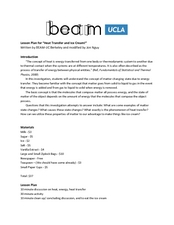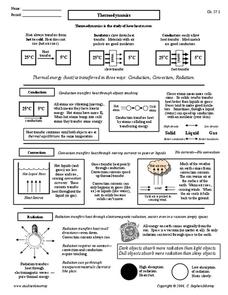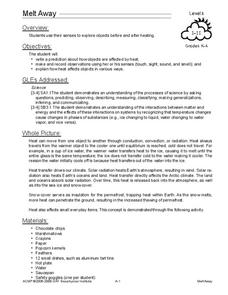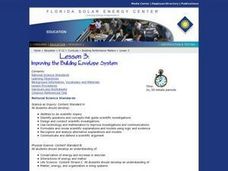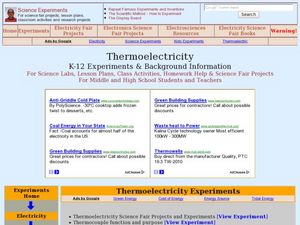Heat Conduction Teacher Resources
Find Heat Conduction lesson plans and worksheets
Showing 805 resources
Curated OER
Conductivity Lessons
"Conduct" some simple experiments with these great lesson plans on conductors and insulators!
Curated OER
Keeping Warm?
Fifth graders explore conductors and heat loss in different materials. In this Physical Science lesson plan, 5th graders will be measuring the temperature drop of water in four containers. The class will then discuss what an...
Rhythm Rhyme Results
Whatʼs the Same and Whatʼs Different?
Learn about radiation, convection, and conduction with a multiple choice worksheet. Each question prompts kids to decide what is different about each form of heat energy transfer, and what is the same.
Curated OER
Cool and Not-So-Cool Materials
Why do some materials feel cool to the touch, but not others? Learn about thermal conductors and thermal insulators with a fun science experiment. First, kids read the results of an experiment with spoons and hot water. They then try...
Columbus City Schools
Keeping It Hot!
Hot off the presses, this collection of thermal energy activities, lessons, and printables is sure to amaze. Demonstrate how thermal energy moves about in a system using simple materials. Pupils demonstrate their understanding...
TED-Ed
What Is Metallic Glass?
Metallic glasses are shiny and opaque, and they conduct heat and electricity like metals. They have a lot of characteristics that make them special and unique to most metals. But, what are they made of? Watch this video to discover what...
US Department of Energy
Geothermal Energy
With Earth Day quickly approaching, as well as many science fairs, why not challenge your class to investigate geothermal energy or other renewable energy resources? There are five driving questions explored in depth here, as well as...
Curated OER
Applications of Energy to the Real World
As an introduction to the concept of energy, this interesting and informative resource would be a terrific addition to a unit. Although there is quite a bit of information presented about kinetic energy, potential energy, and related...
Baylor College
Moving Air
In lab groups, young scientists place aluminum cans with a bubble-solution cap into different temperatures of water to see what size of bubble dome forms. As part of an atmosphere unit in preparation for learning about convection...
Curated OER
"Heat Transfer and Ice Cream!"
Students analyze earth science by creating a frozen treat in class. In this heat transfer instructional activity, students discuss how matter is transformed from solid to liquid and liquid to gas when energy is removed from the equation....
Curated OER
Thermodynamics
In this thermodynamics instructional activity, students learn about insulators and conductors. Students compare the three ways thermal energy is transferred: conduction, convection, and radiation. This instructional activity has 22...
Curated OER
Thermodynamics
In this thermodynamics worksheet, students read about conduction, convection and radiation. They answer 47 questions about heat transfer, thermal equilibrium, insulators, conductors and the states of matter.
Curated OER
Hot Cans and Cold Cans
Students investigate the physics of heating and cooling through conduction, convection, and radiation. Working in groups, they determine the best way to cool a can of water and warm a can of water. Temperature is taken at five minute...
Curated OER
Melt Away
Students explore objects before and after heating using their senses. In this matter and energy lesson, students experiment with a variety of objects and use their senses (except taste) to make predictions and record observations...
Curated OER
Improving the Building Envelope System
Students explain the different heat transfer mechanisms and how they influence the building envelope. They develop ways in which the building envelope can be improved and test hypotheses about building envelope designs.
Curated OER
Thermoelectricity
Students conduct a series of experiments on thermoelectricity. In this physics lesson, students investigate how thermocouple works. They determine the voltage generated when different conductive materials are held at different temperatures.
Curated OER
TE Activity: Hot Cans and Cold Cans
Students work on problems in which they investigate conduction, convection, and radiation. They attempt to maintain the warmth in one can of soda while cooling the other as much as possible in a thirty minute period. They examine how...
Curated OER
The Envelope System: A Partial Solution
Studnet identify examples of conduction, convection and radiation. They develop an example of a building envelope. They also describe how heat transfer mechanisms can affect home energy costs.
Curated OER
Radiation and Color
Tenth graders explore the relationship between color and heat absorption by measuring the temperature change of water in differently colored test tubes as they are exposed to a heat lamp. They work in small groups to collect data and...
Curated OER
Thermodynamics
In this thermodynamics worksheet, high schoolers answer 12 questions about energy, conduction, convection and radiation, heat, the conservation of energy and atoms at different temperatures.
Curated OER
Solar Oven
Sixth graders design two different solar ovens to learn about heat transfer. They investigate the movement of heat between objects by conduction, convection, and radiation. They become aware of things they can't control, like the...
Curated OER
Warming by Freezing
Ninth graders discover the reasoning behind spraying water on fruit and seedlings in preparation for hard freezes. For this conceptual physics lesson, 9th graders conduct an experiment to measure the heat released when water goes from a...
Curated OER
Cooler in the Shadows
Students explore how the amount of sunlight and heat change in areas that are shaded.
Curated OER
Why is it so hot when I sit next to the window?
Students investigate how energy travels through glass. In this energy usage lesson, students conduct an experiment in which they decide if window film affects how much energy travels through the glass. Students use a journal to make...











